Description
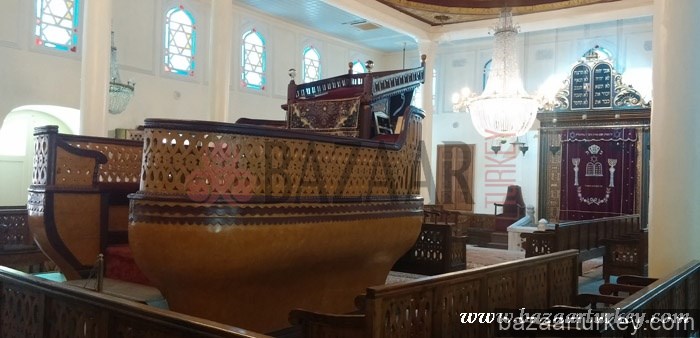
Synagogue Visits In Istanbul.
Jewish community have lived in the geographic area of Asia Minor for more than 2,400 years. In the later Middle Ages, Ashkenazi Jews migrating to the Byzantine Empire and Ottoman Empire supplemented the original Jewish population of Asia Minor. At the end of the 15th century, a large number of Sephardic Jews fleeing persecution in Spain and Portugal settled in Asia Minor on the invitation of the Ottoman Empire. Despite emigration during the 20th century, modern day Turkey continues a Jewish population.
The present size of the Jewish Community is estimated at around 26,000 according to the Jewish Virtual Library. The vast majority live in Istanbul, with a community of about 2,500 in İzmir and other smaller groups located in the rest of Turkey. Sephardic Jews make up approximately 96% of Turkey’s Jewish population, while the rest are primarily Ashkenazic.
Turkish Jews are still legally represented by the Hahambasi, the Chief Rabbi. Rav Izak Haleva, is assisted by a religious Council made up of a Rosh Bet Din and three Hahamim. Thirty-five Lay Counselors look after the secular affairs of the Community and an Executive Committee of fourteen, the president of which must be elected from among the Lay Counselors, runs the daily affairs.
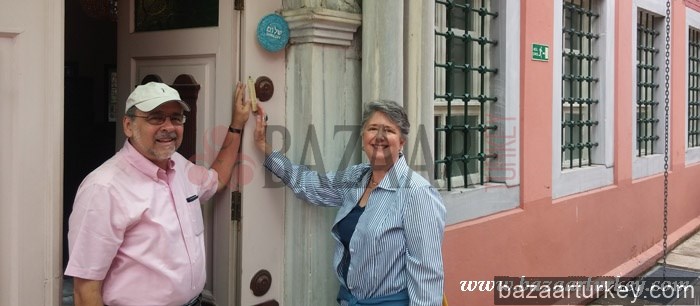
ISTANBUL SYNAGOGUE VISITS & JEWISH HERITAGE TOUR SCHEDULE ;
Half Day jewish Heritage – Half Day Bosphorus Tour Programme
* Pickup from The Hotel
* Ashkenazi Synagogue for Morning Service
* Galata Quarter Visit
* Balat jewish Quarter Walking Tour
* Ahrida Synagogue Visit
* Tea / Coffe Break in a local Patisserie
* Jewish museum- Zulfaris Synagogue
* Rustempasa Mosque Visit
* Local Markets or Spice Bazaar Visit
* End of the Tour and Return Back
( Museum can be replaced by Neve Shalom Synagogue upon request )
The times are given by the rabbinate & times can change according to them.
NOTE : In Turkey because of the security reasons; we need to inform the visitors arrival to the Synagogues
and get a special permission from the rabbinate. In order to do this we need the passport copies of each guests, hotel adresses & ask our guests to fill our a special form that is given by the Rabbinate. e-mail.
Bazaar Turkey – Les Arts Turcs Art Studio
Alemdar Mh. Incili Cavus St.
No: 19 Floor : 3 (Behind The Underground Cistern)
Sultanahmet 34110
Istanbul, Turkey
Contact : Mr. Alp or Mr. Nurdogan ( Phone : +90 544 220 10 22 )
E-mail : info@bazaarturkey.com
Google Maps : https://goo.gl/maps/uXuyRmELZsx
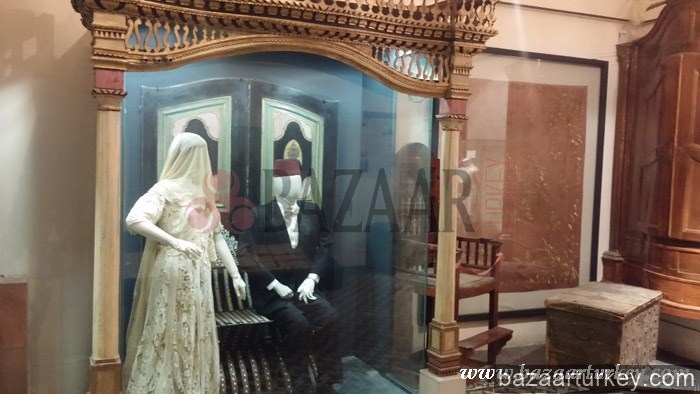
The Ashkenazi Synagogue
Located near the Galata Tower, it is the only active Ashkenazi Synagogue open to visits and prayers. Founded by Ashkenazim of Austrian origin in 1900, it is the last remaining synagogue among a total of three built by Ashkenazim. Visits con be made during weekday mornings and for Shabbat services on Saturday mornings.
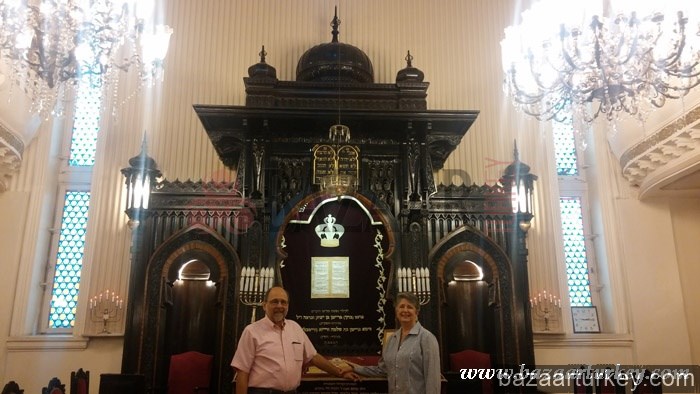
The Neve Shalom Synagogue
Built and opened in 1951 and the scene of a tragic terrorist attack in 1986, it is the largest synagogue in Istanbul where most of the religious ceremonies are held. The Neve Shalom is open to the public for morning visits during the weekdays and for Shabbat prayers every Saturday morning.
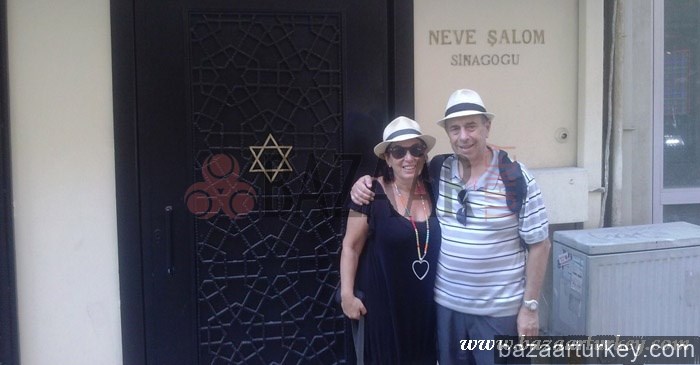
The Ahrida Synagogue
Located in Balat near the Golden Horn, built by Jews of Ohri (Macedonia) more than 550 years ago and recently renovated during the Quincentennial Celebrations in 1992, the Ahrida Synagogue is known foremost by its boat-shaped bimah. It can only be visited during weekday mornings.
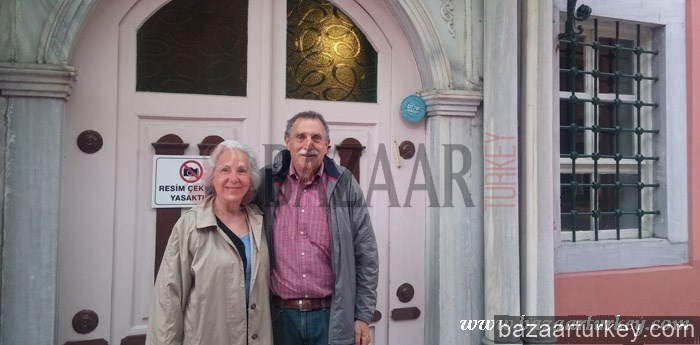
Etz Ahayim Synagogue
Located in Ortakoy, near the European leg of the Bosphorus Bridge. When the previous synagogue burned down in 1941 with only the marble Aron-ha-Kodesh remaining, the new synagogue was rebuilt on the location of the then midrash. Visits can be made with previous appointments and both weekday and Shabbat services can be attended likewise.

Other Synagogues in Istanbul
- Hemdat Israel – Haydarpasa
- Yenikoy Synagogue
- Bet Avraam Synagogue –Sirkeci
- Bakirkoy Synagogue
- Bet Israel Synagogue –Sisli
- Yanbol Synagogue
- Kal Kados Corapci Han Synagogue
- Italian Synagogue
Half Day Jewish Heritage – Half Day Bosphorus Tour
Starting at 08:30 Ends 17:00
1 Guest : 300 Euro pp.
2 – 3Guest : 210 Euro pp.
4 – 6 Guest :170 Euro pp.
7 – 10 Guest : 150 Euro pp.
11 – More Guest : 120 Euro pp.
This is a private full day tour available all year long
Tour includes transportation & guidance.
Includes Entrance Fee & Donations for all synagogues
Early reservation is required.
Special Authorisation is required from the Rabbinate.
Upon request kosher food can be supplied.
Jewish Heritage Tour Guests in Istanbul
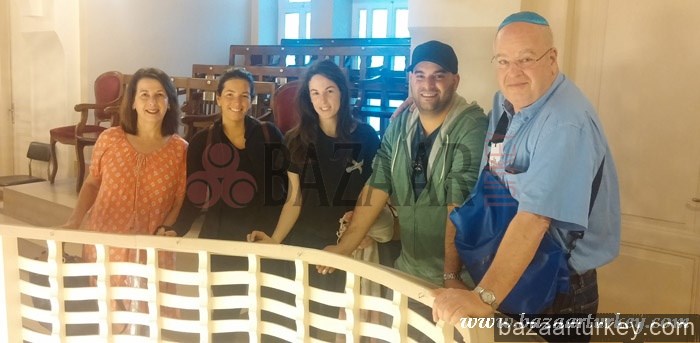
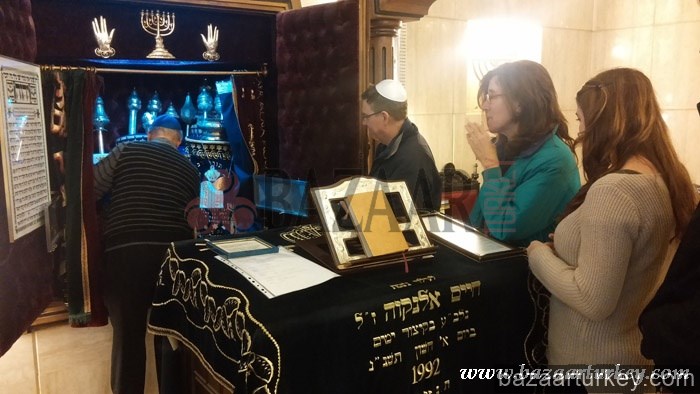
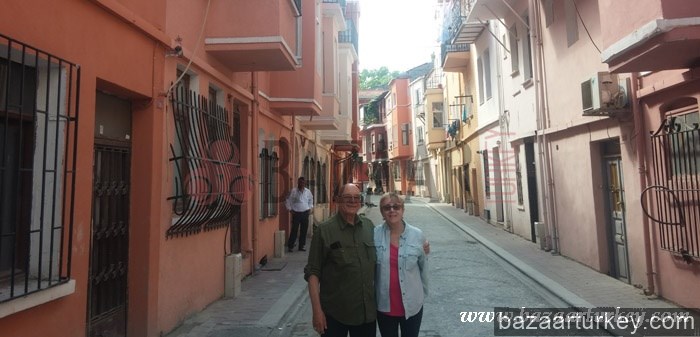




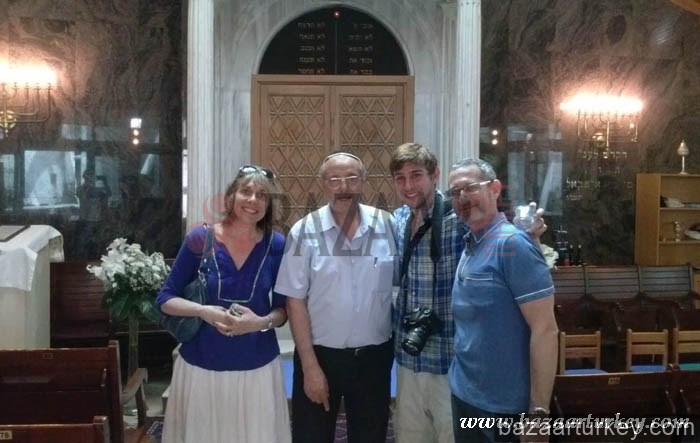
The History of Turkish Jews

Foreword
On the midnight of August 2nd 1492, when Columbus embarked on what would become his most famous expedition to the New World, his fleet departed from the relatively unknown seaport of Palos because the shipping lanes of Cadiz and Seville were clogged with Sephardic Jews expelled from Spain by the Edict of Queen Isabella and King Ferdinand of Spain.
The Jews forced either to convert to Christianity or to “leave” the country under menace “they dare not return… not so much as to take a step on them not trespass upon them in any manner whatsoever” left their land, their property, their belongings all that was theirs and familiar to them rather than abandon their beliefs, their traditions, their heritage.
In the faraway Ottoman Empire, one ruler extended an immediate welcome to the persecuted Jews of Spain, the Sephardim. He was the Sultan Bayazid II.
In 1992, the Discovery year for all those connected to the American continents – North, Central and South – world Jewry was concerned with commemorating not only the expulsion, but also seven centuries of the Jewish life in Spain, flourishing under Muslim rule, and the 500th anniversary of the official welcome extended by the Ottoman Empire in 1492.
This humanitarianism demonstrated at that time, was consistent with the beneficence and goodwill traditionally displayed by the Turkish government and people towards those of different creeds, cultures and backgrounds. Indeed, Turkey could serve as a model to be emulated by any nation which finds refugees from any of the four corners of the world standing at its doors.
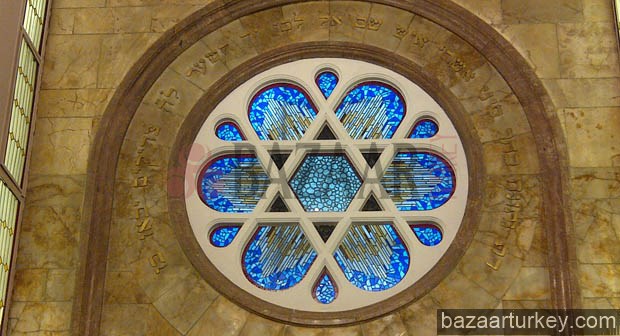
In 1992, Turkish Jewry celebrated not only the anniversary of this gracious welcome, but also the remarkable spirit of tolerance and acceptance which has characterized the whole Jewish experience in Turkey. The events being planned – symposiums, conferences, concerts, exhibitions, films and books, restoration of ancient Synagogues etc – commemorated the longevity and prosperity of the Jewish community. As a whole, the celebration aimed to demonstrate the richness and security of life Jews have found in the Ottoman Empire and the Turkish Republic over seven centuries, and showed that indeed it is not impossible for people of different creeds to live together peacefully under one flag.
A History Predating 1492
The history of the Jews in Anatolia started many centuries before the migration of Sephardic Jews. Remnants of Jewish settlements from the 4th century B.C. have been uncovered in the Aegean region. The historian Josephus Flavius relates that Aristotle “met Jewish people with whom he had an exchange of views during his trip across Asia Minor.”
Ancient synagogue ruins have been found in Sardis, Miletus, Priene, Phocee, etc. dating from 220 B.C. and traces of other Jewish settlements have been discovered near Bursa, in the southeast and along the Aegean, Mediterranean and Black Sea coasts. A bronze column found in Ankara confirms the rights the Emperor Augustus accorded the Jews of Asia Minor.
Jewish communities in Anatolia flourished and continued to prosper through the Turkish conquest. When the Ottomans captured Bursa in 1326 and made it their capital, they found a Jewish community oppressed under Byzantine rule. The Jews welcomed the Ottomans as saviours. Sultan Orhan gave them permission to build the Etz ha-Hayyim (Tree of Life) synagogue which remained in service until nineteen forties.
Early in the 14th century, when the Ottomans had established their capital at Edirne, Jews from Europe, including Karaites, migrated there. (1) Similarly, Jews expelled from Hungary in 1376, from France by Charles VI in September 1394, and from Sicily early in the 15th century found refuge in the Ottoman Empire. In the 1420s, Jews from Salonika, then under Venetian control, fled to Edirne. (2)
Ottoman rule was much kinder than Byzantine rule had been. In fact, from the early 15th century on, the Ottomans actively encouraged Jewish immigration. A letter sent by Rabbi Yitzhak Sarfati (from Edirne) to Jewish communities in Europe in the first part of the century “invited his co-religionists to leave the torments they were enduring in Christiandom and to seek safety and prosperity in Turkey”. (3)
When Mehmet II “the Conqueror” took Constantinople in 1453, he encountered an oppressed Romaniot (Byzantine) Jewish community which welcomed him with enthusiasm. Sultan Mehmet II issued a proclamation to all Jews “… to ascend the site of the Imperial Throne, to dwell in the best of the land, each beneath his Dine and his fig tree, with silver and with gold, with wealth and with cattle…”. (4)
In 1470, Jews expelled from Bavaria by Ludvig X found refuge in the Ottoman Empire. (5)
A Haven for Sephardic Jews
Sultan Bayazid II’s offer of refuge gave new hope to the persecuted Sephardim. In 1492, the Sultan ordered the governors of the provinces of the Ottoman Empire “not to refuse the Jews entry or cause them difficulties, but to receive them cordially”; (6) According to Bernard Lewis, “the Jews were not just permitted to settle in the Ottoman lands, but were encouraged, assisted and sometimes even compelled”.
Immanual Aboab attributes to Bayazid II the famous remark that “the Catholic monarch Ferdinand was wrongly considered as wise, since he impoverished Spain by the expulsion of the Jews, and enriched Turkey”. (7)
The arrival of the Sephardim altered the structure of the community and the original group of Romaniote Jews was totally absorbed.
Over the centuries an increasing number of European Jews, escaping persecution in their native countries, settled in the Ottoman Empire. In 1537 the Jews expelled from Apulia (Italy) after the city fell under Papal control, in 1542 those expelled from Bohemia by King Ferdinand found a safe haven in the Ottoman Empire. (8) In March of 1556, Sultan Suleyman “the Magnificent” wrote a letter to Pope Paul IV asking for the immediate release of the Ancona Marranos, which he declared to be Ottoman citizens. The Pope had no other alternative than to release them, the Ottoman Empire being the “Super Power” of those days.
By 1477, Jewish households in Istanbul numbered 1647 or 11% of the total. Half a century later, 8070 Jewish houses were listed in the city.
The Life of Ottoman Jews
For 300 years following the expulsion, the prosperity and creativity of the Ottoman Jews rivalled that of the Golden Age of Spain. Four Turkish cities: Istanbul, Izmir, Safed and Salonica became the centres of Sephardic Jewry.
Most of the court physicians were Jews: Hakim Yakoub, Joseph and Moshe Hamon, Daniel Fonseca, Gabriel Buenaventura to name only very few.
One of the most significant innovations that Jews brought to the Ottoman Empire was the printing press. In 1493, only one year after their expulsion from Spain, David & Samuel ibn Nahmias established the first Hebrew printing press in Istanbul.
Ottoman diplomacy was often carried out by Jews. Joseph Nasi, appointed the Duke of Naxos, was the former Portuguese Marrano Joao Miques. Another Portuguese Marrano, Alvaro Mendes, was named Duke of Mytylene in return of his diplomatic services to the Sultan. Salamon ben Nathan Eskenazi arranged the first diplomatic ties with the British Empire. Jewish women such as Dona Gracia Mendes Nasi “La Seniora” and Esther Kyra exercised considerable influence in the Court.
In the free air of the Ottoman Empire, Jewish literature flourished. Joseph Caro compiled the Shulhan Arouh. Shlomo haLevi Alkabes composed the Lekhah Dodi a hymn which welcomes the Sabbath according to both Sephardic and Ashkenazi ritual. Jacob Culi began to write the famous MeAm Loez. Rabbi Abraham ben Isaac Assa became known as the father of Judeo-Spanish literature.
On October 27,1840 Sultan Abdulmecid issued his famous ferman concerning the “Blood Libel Accusation” saying: “… and for the love we bear to our subjects, we cannot permit the Jewish nation, whose innocence for the crime alleged against them is evident, to be worried and tormented as a consequence of accusations which have not the least foundation in truth…”.
Under Ottoman tradition, each non-Muslim religious community was responsible for its own institutions, including schools. In the early 19th century, Abraham de Camondo established a modern school, “La Escola”, causing a serious conflict between conservative and secular rabbis which was only settled by the intervention of Sultan Abdulaziz in 1864. The same year the Takkanot haKehilla (By-laws of the Jewish Community) was published, defining the structure of the Jewish community.
An important event in the life of Ottoman Jews in the 17th century was the schism led by Sabetay Sevi, the pseudo Messiah who lived in Izmir and later adopted Islam with his followers.
Equality and a New Republic
Efforts at reform of the Ottoman Empire led to the proclamation of the Hatt-ı Humayun in 1856, which made all Ottoman citizens, Muslim and non-Muslim alike, equal under the law. As a result, leadership of the community began to shift away from the religious figure to secular forces.
World War I brought to an end the glory of the Ottoman Empire. In its place rose the young Turkish Republic. Mustafa Kemal Ataturk was elected president, the Caliphate was abolished and a secular constitution was adopted.
Recognized in 1923 by the Treaty of Lausanne as a fully independent state within its present day borders, Turkey accorded minority rights to the three principal non-Muslim religious minorities and permitted them to carry on with their own schools, social institutions and funds. In 1926, on the eve of Turkey’s adoption of the Swiss Civil Code, the Jewish Community renounced its minority status on personal rights.
During the tragic days of World War II, Turkey managed to maintain its neutrality. As early as 1933 Ataturk invited numbers of prominent German Jewish professors to flee Nazi Germany and settle in Turkey. Before and during the war years, these scholars contributed a great deal to the development of the Turkish university system. During World War II Turkey served as a safe passage for many Jews fleeing the horrors of the Nazism. While the Jewish communities of Greece were wiped out almost completely by Hitler, the Turkish Jews remained secure. Several Turkish diplomats, Ambassadors Behic Erkin and Numan Menemencioglu; Consul-Generals Fikret Sefik Ozdoganci, Bedii Arbel, Selahattin Ulkumen; Consuls Namik Kemal Yolga and Necdet Kent, just to name only few, made every effort to save the Turkish Jews in the Nazi occupied countries, from the Holocaust. They succeeded. Mr. Salahattin Ulkumen, Consul General at Rhodes in 1943-1944, was recognized by the Yad Vashem as a Righteous Gentile “Hassid Umot ha’Olam” in June 1990. Turkey continues to be a shelter, a haven for all those who have to flee the dogmatism, intolerance and persecution.
Turkish Jews Today
The present size of Jewish Community is estimated at around 25.000. The vast majority live in Istanbul, with a community of about 2.500 in Izmir and other smaller groups located in Adana, Ankara, Antakya, Bursa, Canakkale, Kirklareli etc. Sephardim make up 96% of the Community, with Ashkenazim accounting for the rest. There are about 100 Karaites, an independent group who does not accept the authority of the Chief Rabbi.
Turkish Jews are legally represented, as they have been for many centuries, by the Hahambasi, the Chief Rabbi. He is assisted by a religious Council made up of five Hahamim. Fifty Lay Counsellors look after the secular affairs of the Community and an Executive Committee of fourteen runs the daily matters. Representatives of Jewish foundations and institutions meet four times a year as a so-called ??think tank?? to exchange opinions on different subjects concerning the Turkish Jewry.
Synagogues are classified as religious foundations (Vakifs). There are 18 synagogues in use in Istanbul today. Three are in service in holiday resorts, during summer only. Some of them are very old, especially Ahrida Synagogue in the Balat area, which dates from middle15th century. The 15th and 16th century Haskoy and Kuzguncuk cemeteries in Istanbul are still in use today.
??The Museum of Turkish Jews?? (Türk Musevileri Müzesi), the first such Museum in Turkey, has been inaugurated on November 25,2001. (Details at the end of this article)
Education, Language and Social Life
Most Jewish children attend state schools or private Turkish or foreign language schools, and many are enrolled in the universities. Additionally, the Community maintains in Istanbul a school complex including elementary and secondary schools for around 700 students. Turkish is the language of instruction, and Hebrew is taught 3 to 5 hours a week.
While younger Jews speak Turkish as their native language, the over-70-years-old generation is more at home speaking in French or Judeo-Spanish (Ladino). A conscious effort is spent to preserve the heritage of Judeo-Spanish.
For many years Turkish Jews have had their own press. La Buena Esperansa and La Puerta del Oriente started in Izmir in 1843 and Or Israel was first published in Istanbul ten years later. Now one newspaper survives: SALOM (Shalom), a fourteen to sixteen pages weekly in Turkish with one page in Judeo-Spanish.
A Community Calendar (Halila) is published by the Chief Rabbinate every year and distributed free of charge to all those who have paid their dues (Kisba) to the welfare bodies. The Community cannot levy taxes, but can request donations.
Two Jewish hospitals, the 98 bed Or-Ahayim in Istanbul and the 22 bed KaratasHospital in Izmir, serve the Community. Both cities have homes for the aged (Moshav Zekinim) and several welfare associations to assist the poor, the sick, the needy children and orphans.
Social clubs containing libraries, cultural and sports facilities, discotheques give young people the chance to meet.
The Jewish Community is of course a very small group in Turkey today, considering that the total population – 99% Muslim – exceeds 67 million. But in spite of their number the Jews have distinguished themselves. There are several Jewish professors teaching at the Universities of Istanbul and Ankara, and many Turkish Jews are prominent in business, industry, liberal professions and journalism.
(1) Mark Alan Epstein, “The Ottoman Jewish Communities and their role in the 15th and 16th centuries”
(2) Joseph Nehama, “Histoire des Israelites de Salonique”
(3) Bernard Lewis, “The Jews of Islam”
(4) Encyclopedia Judaica, Volume 16 page 1532
(5) Avram Galante, “Histoire des Juifs d’lstanbul”, Volume 2
(6) Abraham Danon, Review Yossef Daath No.4
(7) Immanual Aboab, “A Consolacam as Tribulacoes de Israel, III Israel”
(8) H. Graetz, History of the Jews
by Naim Avigdor GÜLERYÜZ
TIMELINE — Articles by Louis Fisman
Early Settlement
From 4th Century BCE Archaelogical findings indicate Jewish settlement in the Aegean region of Anatolia.
From 220 BCE There are Jewish settlements in Sardes , Miletus , Prien , Bursa in the southeast and along the Aegean ,Mediterranean and Black Sea coasts. A bronze column found in Ankara confirms the rights the Emperor Augustos accorded the Jews of Asia Minor.
Ottoman Period
1299 – 1492 As the Ottoman Empire expands more and more Jewish populations , mostly Romaniot ( Greek-speaking Jews who lived in the Roman Empire ) are incorporated into Ottoman lands. They are officially recognised as dhimmi,a protected non-Muslim community.
1326 The Ottoman capture Bursa and make in their capital. They find a Jewish community oppressed under Byzantine rule.The Jews greet the Ottomans as saviours.
1365 Edirne becomes the Ottoman capital . Jews from Europe including Karaites,migrate there. In the later 14th and 15th centuries ,Jews expelled from Hungary,France,Sicily,Thessalonica(then under Venetian control ) and Bavaria,also find refuge in the Ottoman empire.
1453 Following the conquest of Constantinople,Sultan Mehmet II transfers Jewish populations to their new capital .
1477 Jewish make up % 11 of the total population ( 1,647 households ) of Constantinople..
1492 Sultan Bayezid II welcomes Jews fleeing the Spanish inquisition; in Istanbul , the Jewish population double and Salonika becomes a major Jewish centre.
1516 – 1517 The Ottoman conquest of Palestine and Egypt leads to the strengthening of Jewish communities in their ancient homeland of Eretz Israel.
1535 Approximately 56,000 Jewish live in Istanbul
1556 Sultan Suleyman ‘ the Magnificent’ write a letter to Pope Paul IV asking for immediate release of the Ancona Conversos whom he declared to be Ottoman citizens. The Pope complies.
1626 Shabatai Zvi is born in Izmir. He is to claim himself Messiah and create havoc in the Ottoman lands. Eventually he converts to Islam with his Jewish followers creating a new sect by accepting Islam outwardly but practising a new type of ‘ Sabbatean Judaism ‘ eventually leaving the realm of the Jewish community.
1839 – 1876 The Tanzimat reforms lead to the application of news laws,bringing equality to all Ottoman citizens,regardless of religion.
1870s The French Jewish school network Alliance Israelite Universelle expands throughout the Ottoman Empire in cities with large Jewish populations with a mission to modernise the Jewish communities of the East.
1881 Despite an official Ottoman policy against the modern migration of Jews to Palestine,Russian Jews are welcomed to migrate to the heartland of Ottoman Anatolia (Asia Minor ) where they set up farming communities lasting until World War I .
1908 The Young Turk revolution is supported by a wide coalition of Muslims,Jews,Armenians and Greek who unite under the French slogan of liberte,egalite and fraternite against Sultan Abdulhamid II. Jews enter the public political sphere,with Jews from Salonika,Izmir,Istanbul and Baghdad elected to the Ottoman parliament.Numerous Jewish newspapers are launched in multiple languages such as Judeo-Spanish,French,Turkish and Hebrew..
MODERN TURKEY
1918 WWI sees the demise of the Ottoman Empire.
1920s The Jewish population is at it is maximum at around 150.000
1922-23 Hayim Nahum Turkey’s Chief Rabbi is an adviser to the Turkish delegation to the Lausanne Conference.
1923 The Turkish Republic is founded under the preseidency of Mustafa Kemal ATATURK . The caliphate is abolished and a secular constitution adopted . Non-Muslims become Turkish citizens ushering in Turkification policies. Over time Judeo-Spanish would be phased out and Turkish takes hold as the Jewish communities mother tongue.
1933 Turkey recruits German Jewish academics facing Nazi discriminative policies in order to strengthen Istanbul and Ankara universities.
1934 As a result of pogroms in Edirne and Canakkale the majority of the Jews ıf Thrace migrate to Istanbul.
1940s Turkey stays neutral in World War II
1942 Wealth tax ( varlık vergisi ) places a disproportionately heavy burden on non Muslim communities and sets off a massive migration of Jews to Palestine . Some Jews and other non-Muslims are forced to work in labour camps to pay off debts to the Government.
1948 Israel declares independence leading to continuous immigration throughtout the following years.
1949 Turkey officially recognises the State of Israel.
1951 The grand Neve Shalom synagogue opens in the Jewish neighbourhood of Galata .
1955 Pogroms targeted at the Greek comminity also effect the Jewish comminity and lead to a new round of migration of Israel
1986 Neve Shalom synagogue is attacked by Palestinian terrorists killing 22
1989 The Quincentennial Foundation made up of Turkish Jews and Muslims is established three years before the 500th anniversary of Sephardi life in Ottoman lands and Turkey.
1990s Relations between Turkey and Israel become stronger when a strategic military bond between the two countries emerges.
1994 A modern Jewish school in Ulus opens its doors replacing the former school located in the old Jewish neighbourhood of Galata..
2001 The Zulfaris Synagogue is turned into the Quincentinal Foundation Museum of Turkish Jews providing space to commemorate Jewish Life in the former Ottoman lands and the modern Turkish state.
2002 Ishak Haleva is pronounced Chief Rabbi when Rabbi David Asseo dies after serving for more than 40 years.
2003 16 November Neve Shalom and Bet Israel synagogues are attacked during Shabbat prayers killing 23 people including six Jews . Five days later the British Consulate and HSBC headquarters are bombed. A Turkish militant Islamic group claims responsibility for the attacks but the level of sophistication suggest involvement of international terror organizations.
2004 The European Day of Jewish Culture opens synagogues for the first time to the general Turkish public offering musical and educational activities.
2009 The Jewish community of Turkey stands at about 20,000 . There are 21 synagogues functioning year round another three in the summer. There are 7 in Izmir , 2 in Bursa and one in Ankara and on in Antioch. With the introduciton of a new political order which criticises Turkey’s strong ties to the Jewish state and with popular expressions of antisemitism entering the public sphere Turkish Jews are left questioning what the future will hold……..
Dr. Louis Fishman is assistant professor of Middle East history at Brooklyn College City University of New York.
http://louisfishman.blogspot.com
Chanukah Istanbul ;
Chanukah commemorates the rededication of the Temple in Jerusalem after a group of Jewish warriors defeated the occupying mighty Greek armies.
Chanukah – Dec 25 2016 – Jan 1, 2017
Fast of Tevet 10 Istanbul ;
What happened on 10 Tevet? . . . Why do we need the Holy Temple? . . . The positive aspects of a “siege mentality” . . . The Rebbe on the Holocaust . . . Work permitted
Fast of Tevet 10 – December 23, 2016
Tu B’Shevat Istanbul ;
Tu B’Shevat, the 15th of Shevat on the Jewish calendar, is the day that marks the beginning of a “New Year for Trees.” Falls on Shabbat.
Tu B’Shevat – August 14 2016
Purim Istanbul ;
Purim celebrates the deliverance of the Jewish people from the wicked Haman in the days of Queen Esther of Persia. Work should be avoided. Consult a Rabbi if this is not possible.
Ta’anit Esther
Purim – March 24 2016
Shushan Purim
Passover Istanbul ;
Passover (Pesach) celebrates the deliverance of the Jewish people from slavery in Egypt. Our Passover megasite has tools, guides, insights, stories, inspiration—and just about everything you need to celebrate Passover (but bring your own wine).
Passover – April 23 – 30 – 2016
Second Passover Istanbul ;
Thirty days ago we cleaned our homes and souls of leaven, and matzahed our way through the week-long festival of Passover. And now, Pesach Sheni—a Second Passover! Work permitted
Second Passover – April 25, 2016
Lag B’Omer Istanbul ;
The birthday of Jewish mysticism . . . The spiritual significance of the bow and arrow . . . Can love be true, and can truth be loving? . . . What is Kabbalah? Work permitted
Shavuot Istanbul ;
Shavuot marks the giving of the Torah on Mt. Sinai. The Ten Commandments are read in synagogues, just as they were in the desert on Mt. Sinai over 3,300 years ago. No work is permitted
Shavuot – June 12 – 13 2016
Fast of the 17th of Tammuz Istanbul ;
The “Three Weeks” and Tisha B’Av are designated as a time of mourning over the destruction of the Holy Temple and the galut (exile). Work permitted
Fast of the 14 August 2016
Fast of Tish’a B’Av Istanbul ;
The “Three Weeks” and Tisha B’Av are designated as a time of mourning over the destruction of the Holy Temple and the galut (exile). Work should be avoided. Consult a Rabbi if this is not possible.
Fast of Tish’a B’Av – August 14 2016
The 15th of Av Istanbul ;
Our sages proclaimed the 15th of Av as one of the two greatest festivals of the year, yet they ordained no special observances or celebrations for it . . . Work permitted
Rosh Hashanah Istanbul ;
Virtually everything you need to know about Rosh Hashanah: How-To Guides, Essays and Insights, Holiday Stories, Traditional Recipes, Multimedia, and much more! No work is permitted.
The Month of Elul
Rosh Hashanah – October 3-4 2016
Fast of Gedaliah
Yom Kippur Istanbul ;
Virtually everything you need to know about Yom Kippur, the holiest day on the Jewish calendar: How-To Guides, Essays and Insights, Prayer Service Overviews, Stories, Multimedia, and much more!
Falls on Shabbat.
Yom Kippur – October 12 – 2016
Sukkot Istanbul ;
Virtually everything you need to know about the holiday of Sukkot: How-To Guides, Sukkah and “Four Kinds” Wizards, Essays and Insights, Recipes, Stories, Multimedia, and much more!
No work permitted on September 18 – 19. Work is permitted on September 20 and September 22 – 25 with certain restrictions..
Sukkot – October 17-18 2016
Hoshanah Rabbah – October 19-23 2016
Shemini Atzeret & Simchat Torah Istanbul ;
Virtually everything you need to know about the holidays of Shemini Atzeret and Simchat Torah: How-To Guides, Essays and Insights, Recipes, Stories, Multimedia, and much more!
No work permitted
Shemini Atzeret & Simchat Torah – October 24-25 2016

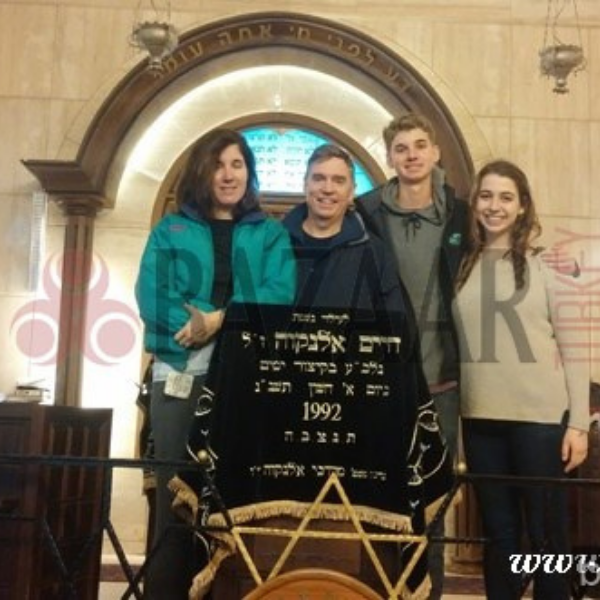



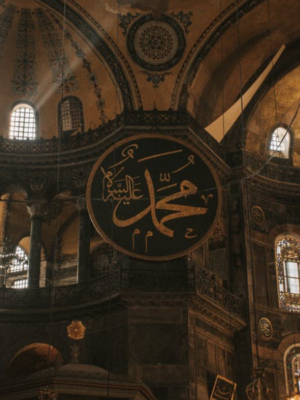
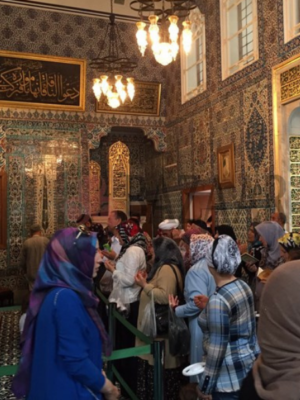
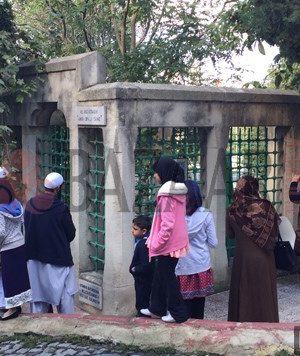
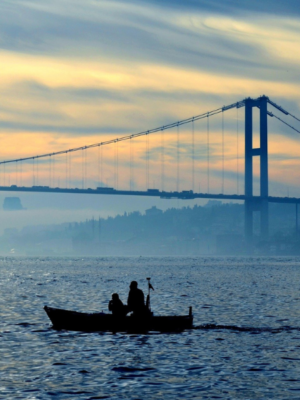

Reviews
There are no reviews yet.